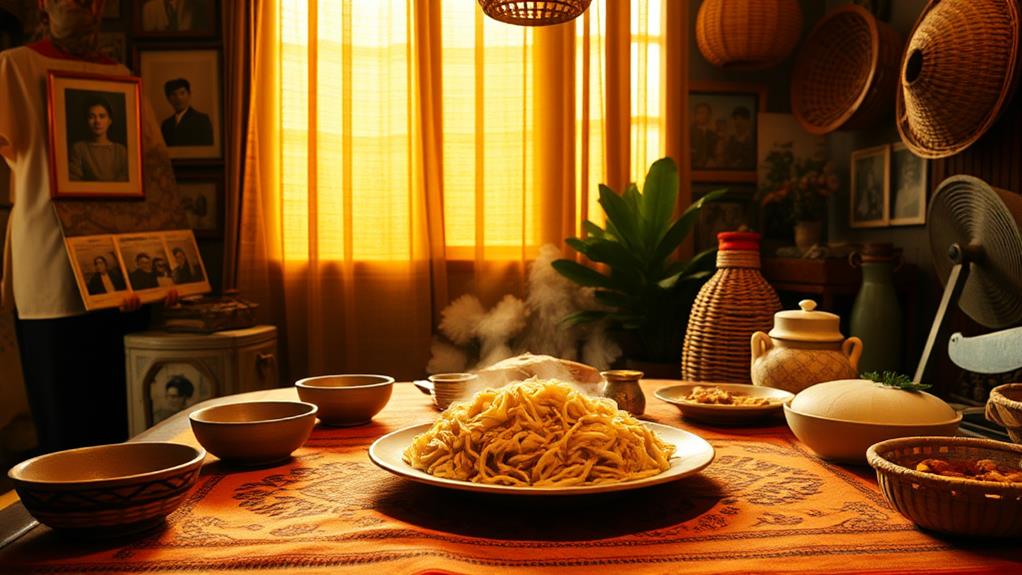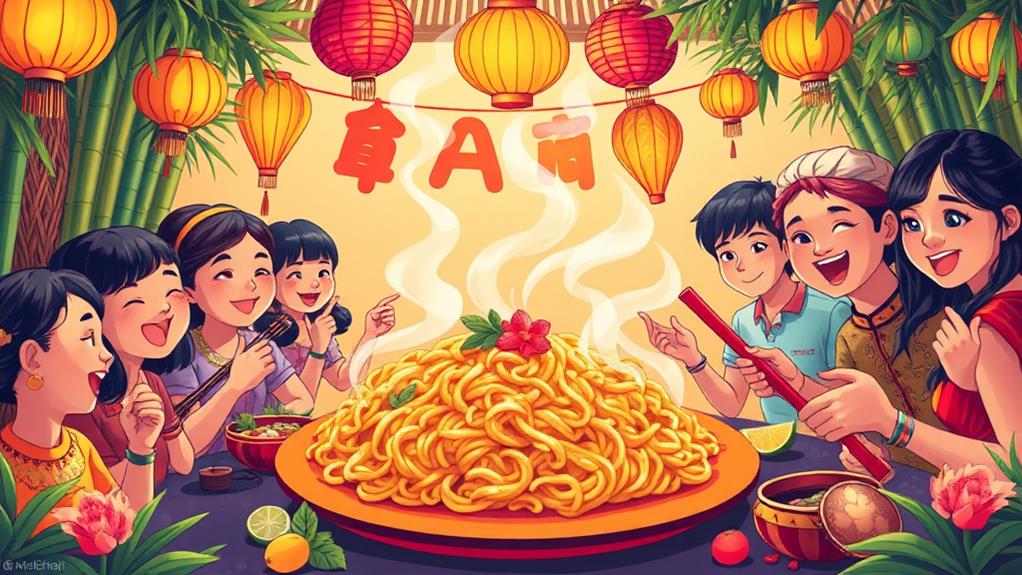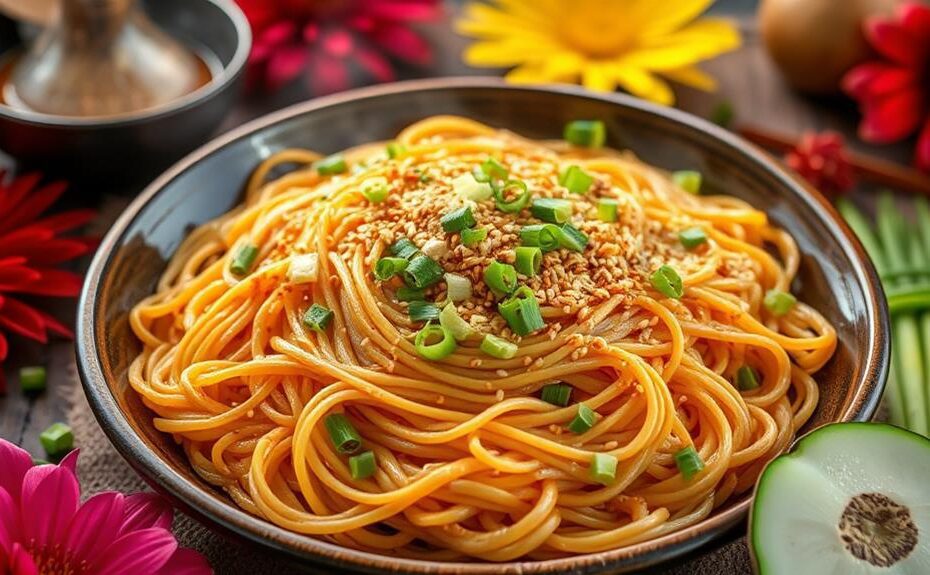Pancit is a Cultural Icon in Filipino Celebrations
When you sit down to enjoy a plate of pancit at a Filipino celebration, you're participating in a centuries-old tradition that represents longevity, prosperity, and community bonding. This beloved dish has its roots in Chinese cuisine, but over time, it has evolved to become a staple of Filipino culinary culture.
Pancit Symbolizes Long Life and Good Fortune
In Filipino culture, pancit is believed to bring long life and good fortune. The long, thin noodles symbolize a long and healthy life, while the act of eating them together with family and friends strengthens bonds and fosters a sense of community.
Regional Variations and Preparation Methods
Pancit has many regional variations, each with its own unique preparation method. For example, Pancit Lugaw, a popular variation from the northern region of the Philippines, is made with a rich, savory broth and topped with vegetables and meat or seafood.
Pancit Bihon, on the other hand, is a popular variation from the southern region, made with thin, rice flour noodles and often served with a sweet and sour sauce.
Pancit Connects Families and Communities
Pancit has become an integral part of Filipino identity, connecting families, immigrants, and communities across generations. Whether it's a birthday, wedding, or holiday celebration, pancit is often at the center of the table, bringing people together and creating lasting memories.
A Cultural Heritage That Runs Deep
The significance of pancit in Filipino culture runs much deeper than just a delicious meal. It represents a cultural heritage that is rich, vibrant, and steeped in tradition.
By enjoying a plate of pancit, you're not just satisfying your appetite – you're participating in a centuries-old tradition that continues to bring people together.
Exploring Pancit's Cultural Roots

Pancit's roots are deeply entrenched in Chinese culinary influence. This is evident in the term "pancit" itself, which originates from the Hokkien Chinese phrase "pian i sit," meaning conveniently cooked.
Early Chinese settlers introduced pancit to the Philippines, initially making it with rice flour for noodle-making, a quicker and easier alternative to traditional rice.
Over time, pancit evolved into a cultural staple, symbolizing long life and good fortune. It's often served during birthdays, weddings, and other significant celebrations.
This cultural significance reflects the profound impact of Chinese culinary influence on Filipino food culture. Pancit has become an integral part of Filipino identity, showcasing the country's cultural heritage and its ability to adapt and blend culinary traditions.
Family Traditions and Celebrations
Pancit's Cultural Significance in Filipino Family Traditions
In the Philippines, pancit is more than just a popular dish; it's an integral part of family traditions and celebrations. It symbolizes long life and prosperity for the celebrant.
Birthdays: On birthdays, pancit takes center stage, representing a long and prosperous life for the celebrant. Grandparents often remind children to enjoy the dish while wishing them longevity.
Weddings: At weddings, pancit represents unity and continuity of the newlywed couple. It's a reminder of the couple's commitment to each other and their future together.
New Year's: During New Year's celebrations, pancit is served to welcome a prosperous and healthy new year. It's a way to start the year off right with a full stomach and a positive outlook.
Family Gatherings: At family gatherings, pancit strengthens familial bonds and togetherness. It brings people together and fosters a sense of community.
Special Occasions: On special occasions, pancit adds a touch of Filipino culture and tradition. It's a way to connect with one's heritage and pass it down to future generations.
The Significance of Not Cutting Noodles: When serving pancit, it's customary not to cut the noodles. This tradition reflects the belief in preserving the dish's symbolic representation of life and continuity.
A Dish of Immigrant Experience

Pancit: A Dish of Cultural Heritage and Immigrant Experience
Filipino immigrants in the U.S. maintain a strong connection to their cultural heritage through traditional dishes like pancit. This beloved Filipino cuisine, consisting of stir-fried noodles, serves as a tangible link to their roots. When cooking and sharing pancit during special occasions, Filipino Americans reinforce familial bonds and cultural identity in a new environment.
The preparation and enjoyment of pancit highlight the challenges of balancing traditional customs with adaptation to a new culture. It's a reminder of one's roots, a testament to the perseverance of cultural practices across generations.
For instance, when Filipino Americans gather with family and friends to celebrate birthdays and holidays, the pancit recipes they share symbolize community and continuity among Filipino Americans.
By embracing this dish, Filipino Americans are embracing their cultural identity and the immigrant experience that shapes it. The sharing of pancit recipes and cooking techniques across generations ensures the preservation of cultural heritage and traditions.
Pancit has become a symbol of cultural identity and a connection to one's roots in a new environment.
Regional Variations and Adaptations
Regional Variations of Pancit
The Philippines is home to a diverse range of pancit variations, each reflecting local ingredients and culinary traditions.
North to South Variations
From north to south, different regions have their own unique pancit variations. For example, Pancit Canton from Pampanga is a popular variant, while Pancit Malabon from Malabon City has its own distinct flavor.
Pancit Bihon, made with thin rice noodles, is often served during celebrations due to its versatility and cultural significance.
Unique Regional Dishes
Some pancit dishes showcase the distinct customs of their region. For instance, Pancit Habhab is traditionally served on banana leaves, enhancing the dining experience.
Pancit Luglug, featuring thick rice noodles in a vibrant orange sauce, highlights local seafood availability, particularly in coastal areas.
Modern Adaptations
Modern adaptations of pancit, including instant versions, allow for easier access and convenience while maintaining traditional flavors.
This makes pancit a popular choice for both casual and festive gatherings at local Filipino restaurants.
Broader Foodways Stories and Connections

Culinary traditions reflect cultural identities and communal bonds. The significance of pancit in Filipino celebrations goes beyond its delicious taste. It embodies cultural identity and communal connections, bringing people together during important life events. The long noodles symbolize longevity and continuity, reinforcing themes of prosperity and good fortune.
Similar culinary practices exist across cultures, where specific dishes signify important milestones and communal bonds. For instance, in Japan, soba noodles are traditionally eaten on New Year's Eve to ensure long life and good health. These dishes transcend geographical boundaries, highlighting the universal language of love, community, and tradition.
The adaptability of pancit showcases cultural fusion and heritage. With its various regional variations, pancit demonstrates the blending of cultural influences and the importance of food in maintaining heritage and connection to one's roots.
By exploring these foodways stories and connections, we discover that the cultural significance of pancit extends beyond Filipino celebrations, revealing a common thread of community and tradition across cultures.
The Origins and Evolution of Pancit
The Origins of Pancit
The term "pancit" originates from the Hokkien Chinese phrase "pian e sit," meaning conveniently cooked, reflecting its quick preparation method introduced by Chinese traders in the Philippines.
Adaptation and Popularity
Pancit was adapted from rice flour during its introduction to the Philippines, as it was easier to cook compared to traditional rice.
The dish gained popularity during the Spanish occupation, becoming the first takeout food as panciteros catered to factory workers, leading to the establishment of panciterias.
Regional Variations
Over the centuries, various regional adaptations of pancit emerged, including Pancit Canton, Pancit Bihon, and Pancit Malabon, each reflecting local ingredients and culinary styles.
Historical Significance
The first recorded mention of pancit dates back to the 18th century, highlighting its deep-rooted presence in Filipino culinary culture as a symbol of longevity and prosperity during celebrations.
Cultural Significance
The evolution of pancit is a reflection of the cultural significance it holds in Filipino celebrations, symbolizing longevity, prosperity, and community bonding.
Cultural Significance in Filipino Heritage

Pancit's Cultural Significance in Filipino Heritage
Pancit's importance in Filipino culture goes beyond its origins and evolution. It symbolizes long life and good fortune, and its preparation and consumption are deeply rooted in cultural traditions.
The Noodles Represent Life and Continuity
The long strands of noodles in pancit represent life and continuity. This association with longevity is reinforced by the cultural belief that cutting the noodles during preparation would cut short one's life. As a result, families take great care not to cut the noodles when preparing pancit for special occasions.
Fostering Community and Cultural Heritage
Pancit is often served during significant events like birthdays and weddings, where families gather to prepare and enjoy the dish together. This shared experience fosters a sense of community and cultural heritage, emphasizing the importance of tradition and family ties.
An Integral Part of Filipino Celebrations
As a staple dish in Filipino celebrations, pancit reflects the fusion of cultural influences and regional variations across the Philippines. Its significance extends beyond the dish itself, representing the country's rich cultural identity.
How Does the Cultural Significance of Pancit Dish Play a Role in Filipino Celebrations?
Pancit: a filipino favorite, plays a significant role in Filipino celebrations due to its cultural significance. It symbolizes long life and prosperity, making it a staple in birthdays, weddings, and other special occasions. The act of preparing and sharing pancit brings people together, strengthening family and community ties.
Pancit's Impact on Filipino Identity
Pancit's Significance in Filipino Identity
Pancit Unites Filipino Communities
Pancit serves as a unifying element within Filipino communities, fostering a sense of belonging and collective identity.
Communal gatherings centered around pancit strengthen social bonds and create a shared sense of heritage. This is evident in the numerous Filipino celebrations where pancit is always present, such as fiestas, birthdays, and holidays.
Pancit Represents Cultural Heritage
The tradition of serving pancit at significant life events reinforces familial ties and respect for cultural heritage.
In the Philippines, pancit is a staple dish at special occasions, symbolizing long life, prosperity, and good fortune. This is reflected in the custom of not cutting the noodles, which signifies the wish for longevity and connects generations through shared practices and beliefs.
Pancit Reflects Regional Diversity
Each variant of pancit represents regional diversity and adaptation, showcasing the rich culinary landscape of the Philippines.
From the spicy pancit habhab of Quezon Province to the sweet pancit molo of Iloilo, each region boasts its unique take on this beloved dish.
Pancit Shapes Filipino Identity
As a staple in Filipino celebrations, pancit shapes your perception of Filipino identity, reflecting values of respect, continuity, and communal bonding.
Through pancit, Filipinos express their cultural identity, emphasizing the importance of tradition, community, and collective heritage.
Frequently Asked Questions
What Is the Cultural Significance of Pancit?
Pancit's Cultural Significance
Pancit is a dish deeply rooted in Filipino culture, shaped by Chinese influences. This cultural fusion is evident in the dish's preparation and significance.
Pancit symbolizes long life and continuity, reflected in the tradition of not cutting the noodles during preparation.
Regional Variations Celebrate Diversity and Unity
Pancit has various regional variations, such as Pancit Bihon and Pancit Canton, which showcase the country's cultural diversity.
Despite these differences, pancit remains a unifying element in Filipino celebrations.
More Than a Dish
Pancit is more than just a meal; it's a symbol of community and family bonds. Made with rice noodles and other ingredients, pancit brings people together during special occasions, reinforcing the importance of relationships in Filipino culture.
What Is the Cultural Significance of Food in the Philippines?
Food is an integral part of Philippine culture, playing a vital role in shaping the nation's identity. In the Philippines, communal dining is a common feature of festivals, highlighting the importance of food in fostering community bonds. For example, the MassKara Festival in Bacolod City, known for its vibrant street dancers and colorful costumes, features a variety of local dishes, such as inasal (grilled meat) and kinilaw (raw fish in vinegar), which are shared among festival-goers.
Family gatherings and celebrations in the Philippines are incomplete without a diverse spread of dishes. Each dish has its own regional variations and symbolism, showcasing the country's rich culinary heritage. For instance, lechon (roasted pig) is a staple at special occasions, symbolizing prosperity and good fortune.
Adobo, a popular dish made with meat or seafood cooked in vinegar, soy sauce, and garlic, represents the country's cultural diversity, with different regions offering their own unique twists on the recipe.
Food serves as a powerful symbol of love, respect, and togetherness in the Philippines. It brings people together, fostering a sense of community and social bonding. In Filipino culture, food is often used as a way to show respect and hospitality to guests, with hosts taking great pride in preparing elaborate meals for their visitors.
What Is the Cultural Significance of Noodles in China?
Noodles have been a staple in Chinese cuisine for over 4,000 years, with a rich cultural significance that spans centuries. Longevity is symbolized by noodles, and their uncut length is crucial to maintain this symbolism.
China boasts a diverse array of noodle variations, each with its own unique preparation methods. Wheat noodles, for instance, are commonly consumed in Northern China, while rice noodles are popular in Southern China.
Noodles play a significant role in Chinese festivals and traditions. During Lunar New Year celebrations, noodles are served as a symbol of longevity and good fortune.
Additionally, noodle etiquette is an important aspect of Chinese dining culture. For example, it is considered impolite to leave your chopsticks standing upright in your bowl, as this is reminiscent of funeral rituals.
What Is the Filipino Noodle Tradition?
The Filipino noodle tradition is a rich cultural heritage. It comprises various noodle variations, each with its own regional differences and preparation methods.
For instance, pancit bihon and canton are two popular types of noodles that hold significant cultural meanings. In festive occasions and family gatherings, these noodles symbolize long life and good wishes.
These noodles bring people together, strengthening cultural identity and heritage. They play a significant role in special events, such as birthdays, weddings, and holidays, where they're often served as a symbol of unity and celebration.
By exploring this tradition, one can uncover the importance of noodles in Filipino culture and their role in preserving cultural heritage.
